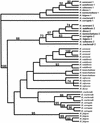Positive selection in the egg receptor for abalone sperm lysin
- PMID: 12676995
- PMCID: PMC153608
- DOI: 10.1073/pnas.0830022100
Positive selection in the egg receptor for abalone sperm lysin
Abstract
The mechanism of speciation is a central problem in evolutionary biology. In free-spawning animals with no complex mating behavior, prezygotic reproductive isolation (speciation) could result from the rapid divergence of genes coding for sperm and egg proteins that bind each other during fertilization. In abalone, sperm lysin evolves rapidly by positive Darwinian selection. The egg vitelline envelope receptor for lysin had previously been shown to evolve neutrally and be subjected to concerted evolution. Several mathematical simulations predict that both male and female reproductive proteins should evolve rapidly by positive selection. Here we report that the sequence diversity of the amino-terminal end of the egg vitelline envelope receptor for lysin has been promoted by positive Darwinian selection. These data provide molecular support for theoretical models showing that the two sexes are locked in a "coevolutionary chase" that could be driven by processes such as sexual selection, sexual conflict, or microbial attack (pathogen avoidance). The result of this continuous coevolution of the gamete recognition system could be the splitting of one population into two that are reproductively isolated (speciation).
Figures


References
Publication types
MeSH terms
Substances
Associated data
- Actions
- Actions
- Actions
- Actions
- Actions
- Actions
- Actions
Grants and funding
LinkOut - more resources
Full Text Sources
Other Literature Sources

